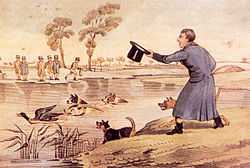Duck-baiting

Duck-baiting is a blood sport involving the baiting of ducks.
Overview
Duck-baiting involved releasing a pinioned duck on to a pond. The dog dived into the pond coursing the duck, which was unable to fly. A spectacular diving exhibition ensued, as the duck dived the dog dived to pursue. Inevitably, the dog could not match the duck's speed underwater and would surface in rage. Spectators would gamble and joined in the noise to encourage their animal of choice. Those who backed the dog might throw stones at the duck in an attempt to disable it, which caused fights among the spectators. The dogs would take turns catching the duck. Prizes would be awarded to the dogs that caught the duck in the least amount of time.[1]
Strutt's Sports and Pastimes says of duck-baiting:
- "another barbarous pastime and for the performance it is necessary to have recourse to a pond of water sufficiently extensive to give the duck plenty of room for making her escape from the dogs, when she is closely pursued; which she does by diving as often as any of them come near to her."[2]
It was a favourite spectator sport for Charles II of England.[3][4]
Locations
Duck-baiting events were held in and around London. Rural inns, with names like "The Dog and Duck",[5][3] located in St George's Fields,[6] Brixton, Hampstead, Dulwich, Stamford Hill, Tottenham, Stoke-on-Trent, Newington and Tooting had ponds where the baiting took place. On the weekends, families, friends and their fighting dogs would frequent these locations.
Decline
The rowdy assemblies associated with the activity caused public alarm.[7] Duck-baiting declined in the late nineteenth century,[3] and eventually ceased altogether due to rioting and damage incurred to the inns.
References
- ↑ Homan, M. (2000). A Complete History of Fighting Dogs pp 109–110 Howell Book House Inc. ISBN 1-58245-128-1
- ↑ Strutt, Joseph (1810) Glig-Gamena Angel-Deod, Or Sports and Pastimes of the People of England (2nd edition) White and Company, London, pages 251–252, OCLC 2552476
- ↑ 3.0 3.1 3.2 Wright, Gordon (2006) The Dictionary of Pub Names Wordsworth Editions, Ware, Hertfordshire, England, page 116, ISBN 1-84022-266-2
- ↑ Collins, Tony and Vamplew, Wray (2002) Mud, Sweat and Beers: A cultural history of sport and alcohol Berg, Oxford, England, page 8, ISBN 1-85973-553-3
- ↑ Delderfield, Eric R. (1965) British inn signs and their stories E.R.D. Publications, Exmouth, England, page 77, ISBN 0-7153-4022-0
- ↑ Walford, Edward, Old and New London, A Narrative of its History, its People and its Places.Illustrated with Numerous Engravings from the Most Authentic Sources. vol 6, 1872–78. Electronic Resource. Permanent URL: http://hdl.handle.net/10427/15579.
- ↑ "Have you seen in the neighbourhood of the church or churchyard duck-hunting or dogfighting?"-"There is scarcely a Sunday there is not. I have gone out with the greatest anxiety when my wife and family were going to church to protect them." James May, vestry clerk of St Matthew's Bethnal-Green, 1817: quoted in The Times, 25 August 1834, p. 4
Further reading
- Fleig, Dieter (1996) History of Fighting Dogs T.F.H. Publications, Neptune City, New Jersey, ISBN 0-7938-0498-1